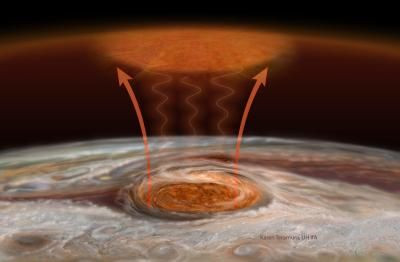Jupiter's Great Red Spot Is Shrinking, But The Planet Remains Hot: Here's Possibly Why

An energy mystery that has long confused scientists may have been solved. Astronomers have wondered about the source of Jupiter’s high temperatures in its upper atmosphere considering the planet is so far away from the Sun — 483.8 million miles, to be precise. But a team of astronomers in the U.S. and U.K. have used an infrared telescope in Hawaii to find the source: Jupiter’s Great Red Spot.
The Great Red Spot is a giant storm first discovered in the 17th century and has lasted for more than 150 years. Its color and size has varied over time — it currently measures three times the diameter of Earth and is reportedly shrinking — with winds as high as 400 mph.
The scientists, who published their findings in the Nature science journal, measured the non-visible, infra-red light the gaseous planet emits in order to gauge the temperature of the upper atmosphere 500 miles higher than the planet’s rim.
"With solar heating from above ruled out, we designed observations to map the heat distribution over the entire planet in search for any temperature anomalies that might yield clues as to where the energy is coming from," said Dr. James O'Donoghue, research scientist at Boston University and lead author of the study, in a news release.
The team found the hurricane to be 2,732 degrees Fahrenheit warmer than the rest of the gaseous planet, suggesting that the storm may play a role in the heat flow on the planet.
"The Great Red Spot is a terrific source of energy to heat the upper atmosphere at Jupiter, but we had no prior evidence of its actual effects upon observed temperatures at high altitudes," said Luke Moore, a study co-author and research scientist in the Center for Space Physics at BU, in a news release.
© Copyright IBTimes 2025. All rights reserved.






















